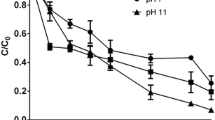Abstract
Gatifloxacin, an antimicrobial drug belonging to the fluoroquinolone family, is active against Gram-positive and Gram-negative bacteria and is extensively used for the control of infections in humans. The presence of the drug in environmental matrices has already been reported. This study investigated the degradation of gatifloxacin in water by hydroxyl radicals generated by the UV254 nm/H2O2 process (\( {\mathrm{C}}_{{\mathrm{H}}_2{\mathrm{O}}_2\mathrm{initial}}= \) 0.4–2.4 mmol L−1) and evaluated the capacity of the radicals to reduce the antimicrobial activity against Gram-positive and Gram-negative bacteria. Acute toxicity assays were performed with Vibrio fischeri, and the degradation products were proposed. The hydroxyl radicals formed in the processes were able to degrade the fluoroquinolone and remove the antimicrobial activity from the aqueous solution. Approximately 97 % gatifloxacin degradation was observed after applying 2.4 mmol L−1 of initial H2O2 concentration and 20 min of UVC254nm irradiation (130 J s−1). The acute toxicity assays showed that the toxicity of the treated solution for V. fischeri increased as the gatifloxacin concentration in the solution decreased.




Similar content being viewed by others
References
Adachi F, Yamamoto A, Takakura K-I, Kawahara R (2013) Occurrence of fluoroquinolones and fluoroquinolone-resistance genes in the aquatic environment. Sci Total Environ 444:508–514
Al-Abdullah, ES (2012) Gatifloxacin. In: Harry, G.B. (ed) Profiles of Drug Substances, Excipients and Related Methodology. Academic Press, pp 183-243
Andreozzi R, Canterino M, Lo Giudice R, Marotta R, Pinto G, Pollio A (2006) Lincomycin solar photodegradation, algal toxicity and removal from wastewaters by means of ozonation. Water Res 40:630–638
Chevremont A-C, Farnet A-M, Coulomb B, Boudenne J-L (2012) Effect of coupled UV-A and UV-C LEDs on both microbiological and chemical pollution of urban wastewaters. Sci Total Environ 426:304–310
da Silva CR, Maniero MG, Rath S, Guimarães JR (2011) Antibacterial activity inhibition after the degradation of flumequine by UV/H2O2. J Adv Oxid Technol 14(1):106–114
de Oliveira AMD, Maniero MG, Guimarães JR (2015) Lomefloxacin degradation: antimicrobial activity, toxicity and byproducts. J Adv Oxid Technol 18:211–220
CETESB - Companhia Ambiental do Estado de São Paulo (2001) Vibrio fischeri: assay method – L5.227, São Paulo.
Edelahi MC (2004) Contribution to the study of the in situ degradation of pesticides by advanced oxidation processes involving the use of iron. Application to the phenylureas herbicides. Thesis, Université de Marne-La-Vallée
Fent K, Weston AA, Caminada D (2006) Ecotoxicology of human pharmaceuticals. Aquat Toxicol 76(2):122–159
Hong P-Y (2015) Antimicrobial resistance and food safety. Jackson, C-Y.C.Y.R. (ed), Academic Press, San Diego, pp. 325-346.
Hubicka U, Żmudzki P, Żuromska-Witek B, Zajdel P, Pawłowski M, Krzek J (2013) Separation and characterization of ciprofloxacin, difloxacin, lomefloxacin, norfloxacin, and ofloxacin oxidation products under potassium permanganate treatment in acidic medium by UPLC-MS/MS. Talanta 109:91–100
Jia A, Wan Y, Xiao Y, Hu J (2012) Occurrence and fate of quinolone and fluoroquinolone antibiotics in a municipal sewage treatment plant. Water Res 46(2):387–394
Jiao S, Zheng S, Yin D, Wang L, Chen L (2008) Aqueous photolysis of tetracycline and toxicity of photolytic products to luminescent bacteria. Chemosphere 73:377–382
Khan JA, Shah NS, Khan HM (2015) Decomposition of atrazine by ionizing radiation: kinetics, degradation pathways and influence of radical scavengers. Sep Purific Technol 156:140–147
Leal RMP, Figueira RF, Tornisielo VL, Regitano JB (2012) Occurrence and sorption of fluoroquinolones in poultry litters and soils from São Paulo State, Brazil. Sci Total Environ 432:344–349
Malato S, Fernández-Ibáñez P, Maldonado MI, Blanco J, Gernjak W (2009) Decontamination and disinfection of water by solar photocatalysis: recent overview and trends. Catal Today 147(1):1–59
Moreira FC, Garcia-Segurab S, Boaventura RAR, Brillas E, Vilar VJP (2014) Degradation of the antibiotic trimethoprim by electrochemical advanced oxidation processes using a carbon-PTFE air-diffusion cathode and a boron-doped diamond or platinum anode. Appl Catal B Environ 160–161:492–505
Peres MS, Maniero MG, Guimaraes JR (2015) Photocatalytic degradation of ofloxacin and evaluation of the residual antimicrobial activity. Photochem Photobiol Sciences 14(3):556–562
Rodrigues-Silva C, Maniero MG, Rath S, Guimarães JR (2013) Degradation of flumequine by photocatalysis and evaluation of antimicrobial activity. J Chem Engin 224:46–52
Rodrigues-Silva C, Maniero MG, Peres MS, Guimarães JR (2014) Occurrence and degradation of quinolones by advanced oxidation processes. Quim Nov. 37:868–885
Rusu A, Hancu G, Uivaroşi V (2015) Fluoroquinolone pollution of food, water and soil, and bacterial resistance. Environ Chem Lett 13(1):21–36
Sanasa (2015) water analysis. http://www.sanasa.com.br/analiseagua/conteudo2.aspx?par_sist=1. Accessed 26 November 2015.
Shen LL, Baranowski J, Pernet AG (1989) Mechanism of inhibition of DNA gyrase by quinolone antibacterials: specificity and cooperativity of drug binding to DNA. Biochem 28:3879–85
Van Doorslaer X, Demeestere K, Heynderickx PM, Van Langenhove H, Dewulf J (2011) UV-A and UV-C induced photolytic and photocatalytic degradation of aqueous ciprofloxacin and moxifloxacin: reaction kinetics and role of adsorption. Appl Catal B Environ 101(3-4):540–547
Vieno NM, Härkki H, Tuhkanen T, Kronberg L (2007) Occurrence of pharmaceuticals in river water and their elimination in a pilot-scale drinking water treatment plant. Environ Sci Technol 41:5077–5084
Wammer KH, Korte AR, Lundeen RA, Sundberg JE, McNeill K, Arnold WA (2013) Direct photochemistry of three fluoroquinolone antibacterials: norfloxacin, ofloxacin, and enrofloxacin. Water Res 47(1):439–448
Xiao Y, Chang H, Jia A, Hu J (2008) Trace analysis of quinolone and fluoroquinolone antibiotics from wastewaters by liquid chromatography–electrospray tandem mass spectrometry. J Chromatogr A 1214(1-2):100–108
Zagatto PA, Bertoletti E (2008) “Aquatic ecotoxicology–principles and applications” (in Portuguese: Ecotoxicologia Aquática – Princípios e Aplicações). RiMa, São Carlos-Brasil
Acknowledgments
The study was financially supported by FAPESP (2014/06064-3, 2014/06201-0, 2013/09543-7, 2013/04656-8) and CNPq (479131/2013-9). Rodrigues-Silva (2014/16622-3) and Maniero (2013/07817-2) acknowledge FAPESP for providing the post-Ph.D scholarships, and M. Caianelo acknowledges CNPq for providing Ph.D scholarship.
Author information
Authors and Affiliations
Corresponding authors
Additional information
Responsible editor: Gerald Thouand
Rights and permissions
About this article
Cite this article
Caianelo, M., Rodrigues-Silva, C., Maniero, M.G. et al. Antimicrobial activity against Gram-positive and Gram-negative bacteria during gatifloxacin degradation by hydroxyl radicals. Environ Sci Pollut Res 24, 6288–6298 (2017). https://doi.org/10.1007/s11356-016-6972-y
Received:
Accepted:
Published:
Issue Date:
DOI: https://doi.org/10.1007/s11356-016-6972-y




